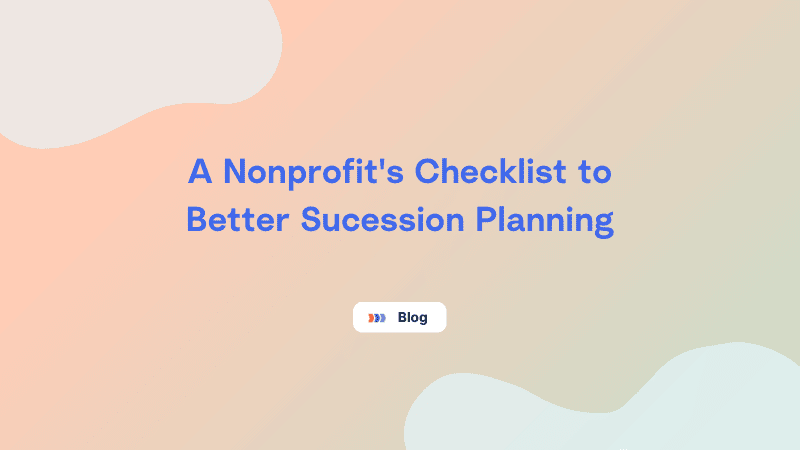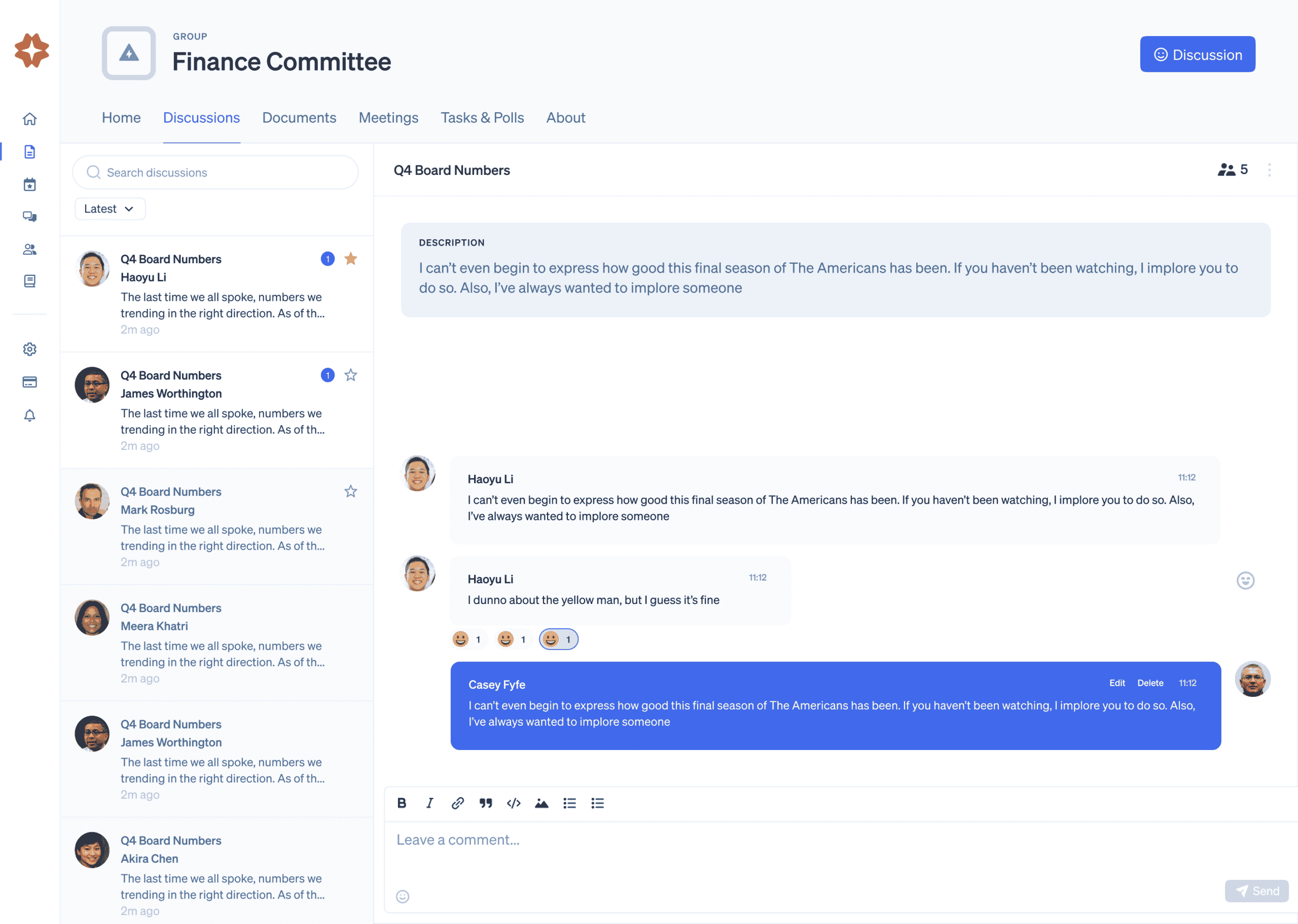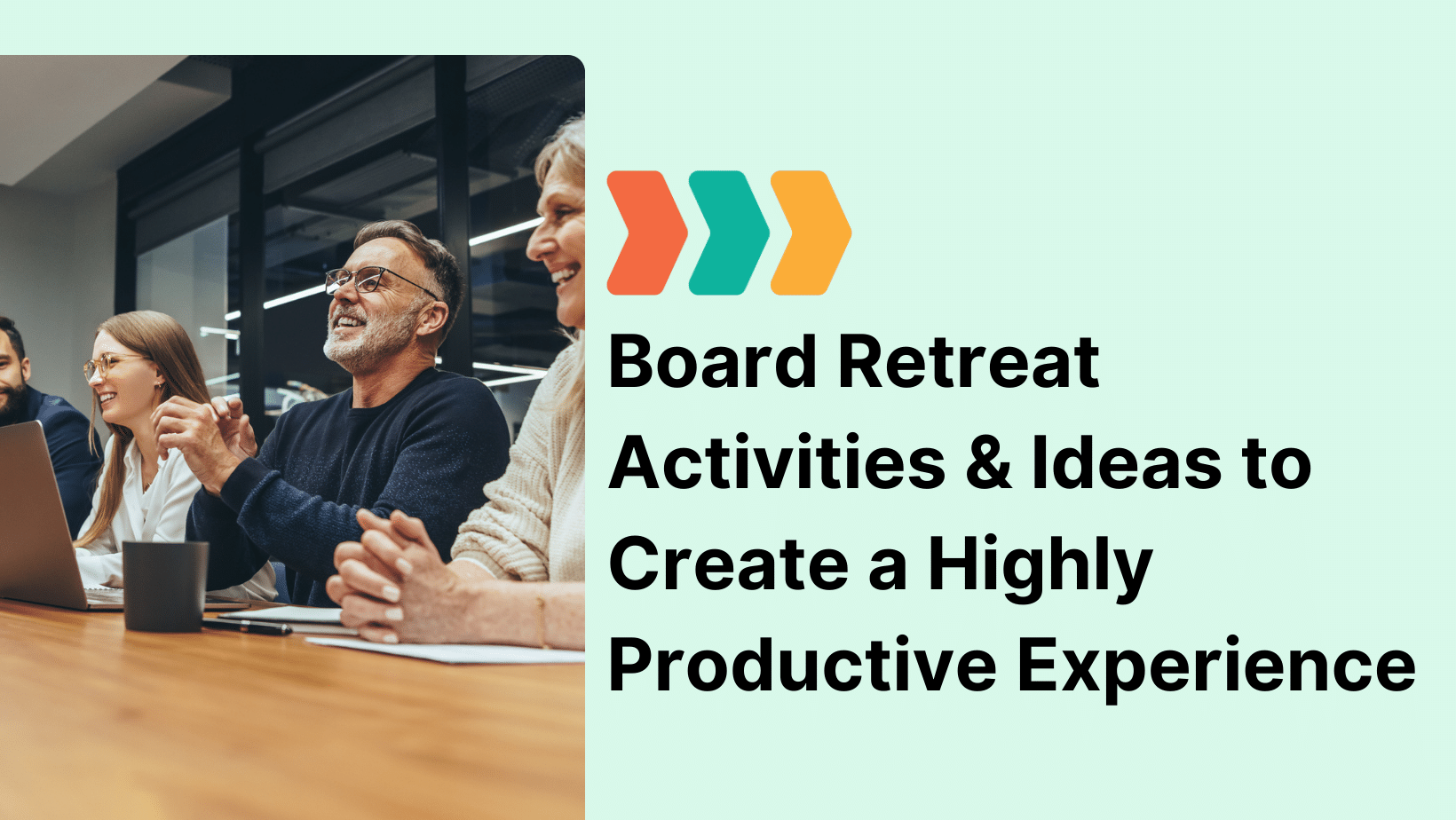Have you ever wondered why you don’t have strong leaders ready to step into your board’s empty positions? If your nonprofit team has ever encountered this situation, you likely haven’t developed a formal board succession plan.
This is the case for a lot of organizations. A major study on nonprofit leadership found that 78% of nonprofits don’t have a formal board succession plan in place, yet 67% of the nonprofit leaders who responded to the survey were planning to exit their position in the next 5 years.
Poor succession procedures can directly impact your organization’s success. Weathering the transition between board members and leaders is a balancing act. Your team will need to keep moving at full speed on your fundraising and strategic initiatives while getting newcomers up to speed on your organization’s priorities and procedures.
At Boardable, we’ve worked with thousands of nonprofit boards to improve board member communications and build more collaborative work environments. We understand that many components play into successful board succession planning, making it difficult to decipher the exact points your team should address. Based on years of experience, we’ve developed this guide that covers everything you need to know, including:
- What is a Board Succession Plan?
- Why is Succession Planning Important for Nonprofit Boards?
- Key Steps for Developing a Board Succession Plan
- Best Practices for Better Board Succession Planning
No matter how stable a nonprofit organization is, eventually things will change. Leaders resign, board tenures end, and strategies evolve. To stay one step ahead, you need to develop airtight succession procedures that your team supports. Without further ado, let’s get started with the basics.

What is a Board Succession Plan?
A board succession plan is a strategic document that outlines the process that boards and committees must follow when replacing board members, board leadership, or the executive director. These plans can help fill an existing vacancy or plan ahead for a future vacancy in one of these positions. A comprehensive succession plan will address both types of departures:
- An emergency departure in which an individual unexpectedly resigns or is removed from the position
- A planned departure in which an individual’s term limit is approaching or they announce an early departure
A well-developed board succession plan enables the nonprofit’s team to minimize negative impacts caused by departures, which helps maintain a consistent workflow during transitions. It should emphasize the composition and diversity of the team that leads and performs the organization’s day-to-day operations and how that team must change in response to a constantly shifting environment.

Why is Succession Planning Important to Nonprofit Boards?
Succession planning is a core part of the management cycle and an organization’s growth strategy. For the nonprofit board, succession planning falls under the fiduciary “duty of care.” This means that board directors are responsible for ensuring the long-term sustainability of the organization, including recruiting and maintaining effective leadership.
Beyond responsible governance, boards pursue sufficient board succession planning for many reasons, such as:
- It allows them to obtain top talent for the team.
- It ensures a diverse team composition, resulting in more inclusive thinking.
- It maintains the balance of power on the board.
- It reinforces trust with stakeholders.
- It results in a more seamless transition between leaders.
Approaches to succession planning fall along a spectrum. Some boards are highly reactive, while others are more strategic. In our experience, boards that experience the best results lean toward a more strategic approach. With all the benefits that a well-organized board succession plan offers, it’s not hard to see why more nonprofits are starting to address this subject.

Key Steps for Developing a Board Succession Plan
Given the importance of sufficient planning, your team will want to make sure it builds out its approach to board succession planning as much as possible. While this may seem like an arduous process, it doesn’t necessarily have to be the intimidating chore that it’s often characterized as. Let’s break it down into a few key steps:
Step 1) Align with board members on the plan.
Everyone has their own perceptions and opinions about what they want to see in board and executive leadership. The topic of leadership is too important for any single person to assume what’s best for the team without asking for input. The best way to get everyone on the same page is to align the team’s vision for your board and its leadership.
Start by forming an ad hoc nominating committee to oversee the process or assign it to your year-round governance committee. If you form an ad hoc nominating committee, slate it with a high-level staff member, at least one board member, and any other trusted individuals who are invested in the process.
They should be tasked with developing and recommending criteria for board composition, addressing board refreshment, creating candidate profiles, and leading the search for candidates. Clearly define each person’s role in choosing well-suited candidates and describe their responsibility to help new leaders successfully transition into their positions.
RELATED: Explore our guide to board committees to learn more about why committees like this exist, what types are usually formed, and what committee structure works best.
Step 2) Assess potential vacancies
Board succession plans aren’t necessarily one-size-fits-all. For your nonprofit to stay on top of departures, your executive director and board chair need to conduct an annual review to assess any upcoming and potential vacancies.
Planned vacancies (like retirements or term limits) are easy to stay on top of, but emergencies (like unexpected resignations) can be difficult to predict. To reiterate, your board succession plan should address both. Emergency planning can be a lifesaver if a key leader unexpectedly resigns or is abruptly terminated.
Determine how long your organization could reasonably leave each key position open without having any negative impacts on the organization. You’ll also want to consider who could fill the position, both long-term and in the interim. Be sure that your bylaws address transitions of all kinds and that you stay in compliance.
If your board lacks faith in any particular individual’s ability to serve, that should be addressed at this point. The committee should immediately focus its efforts on identifying the best possible candidates if the board wishes to remove one of its presiding members.
Step 3) Recruit talented individuals for future transitions
Your committee should start its search early. For planned vacancies, you should begin around 6 months or so in advance. For emergency vacancies, start looking as soon as the news breaks. In either scenario, there are two routes you can take with recruitment:
- Internal talent can bring a lot of value to leadership positions and are familiar with your organization’s culture, resulting in a smooth transition.
- External talent can bring new skills and a fresh perspective, but long-term staff or board members may push back.
Considering the potential resistance to external candidates, most organizations recruit internally for key leadership positions. Because of this, your governance committee should outline a process for internal leadership cultivation in your board succession plan.
For example, the successor for the board chair is most often the vice-chair, and many organizations task the chair with creating learning opportunities for their successor while they still hold the position. After all, the opportune time to prepare a leader is before a vacancy opens up.
Step 4) Establish an onboarding process
Finding the right successor for a vacant position is only half the battle. To ensure success, your nonprofit succession plan should address how the team will onboard the individual into their role. Onboarding is a key part of the transition process and can make or break the individual’s success.
Onboarding is a multi-step process that helps new members of your board familiarize themselves with basic operations, so they can get to work quickly. During the onboarding period, your team should plan to:
- Teach the individual about responsibilities and expectations.
- Assess their progress as they get acclimated to the role.
- Integrate them into the organization’s culture.
- Help them transition from the introductory period into independence in their position.
Having onboarding guidelines in place upfront will make for a smoother transition later on. Create a timeline for new members, and make sure your team is on the same page about who will help with key onboarding responsibilities.
RELATED: Looking to learn more about offering a standout onboarding experience? Check out our complete guide to welcoming new board members.

Best Practices for Better Board Succession Planning
To create a well-written board succession plan, you’ll need to consider how you’ll execute it. That way, your team can spend its time and resources in the most productive way possible. How can boards be more strategic when it comes to succession planning? Let’s take a look at three tactics:
1. Implement a board portal
The use of technology in board succession planning can streamline processes while ensuring they’re properly recorded and implemented. With concrete processes and technology in place, planning is easier, reporting and evaluation are possible, and workflow remains consistent during nonprofit board succession.
Accurate information is the cornerstone for effective board management and engagement. Dedicated technology like Boardable enables boards to collaborate, create plans, and follow up on results to improve overall governance. Ultimately, implementing the right software assists your succession plan by:
- Allowing you to share established processes and maintain consistent workflow during periods of change.
- Attracting and retaining talent, ensuring an adequate pool from which a successor can be chosen.
- Transferring the equity of established donor relationships from team members to the organization and ensuring donors continue to have a positive experience during transitions.
- Improving and accurately measuring the value of your organization.
- Providing a central location to find helpful historical documents and governance information.
The advantages of integrating succession planning and technology are clear: streamlined administration, improved communication, increased engagement, and enhanced governance. Beyond these benefits, it is the responsibility of the board to remove the anxiety surrounding planning for the future, help their executives and leaders appreciate the value of planning ahead, and govern in a manner that protects the organization from rushed and irrational decision-making.
2. Make Board Succession a Priority in the Agenda
With so many responsibilities already on their plates, boards are unlikely to dedicate the time to tackle succession planning. However, it’s crucial to carve out time in both the committee meeting’s agendas and the board’s agendas.
Remember, your nonprofit’s culture has a significant role to play in a succession plan. Your succession team needs time to have a frank dialogue about ongoing refreshment, upcoming vacancies, and the need for specific skill sets.
Stakeholders also have heightened expectations and want to understand whether a succession plan exists, whether it addresses the right skills, and how frequently the topic is discussed. While proxy statement disclosures on board succession planning and practices are fairly limited across the nonprofit sector, it’s worthwhile to consider how your board can provide some transparency on their approach.
3. View it as an Ongoing Process
Succession planning works best when it’s viewed as an ongoing responsibility that’s closely tied to the nonprofit’s overall management strategy. With input from board members and high-level individuals at your organization, your governance committee needs to ensure that it’s continually evaluating criteria and having conversations with your executive director about its plans.
Keep in mind that succession planning is grounded in specific contexts—the economy, industry, and nonprofit’s overall strategy—which all inevitably change. Being on top of these changes allows your board and governance committee to recruit the best talent and develop the best composition for your team.
Conclusion
Too often, boards approach succession planning in an episodic manner. They often only address it when they need to replace a director or other leader, which isn’t surprising since replacement can be a touchy subject. However, sufficient board succession planning is vital to the ongoing success of nonprofits.
In the flurry of board duties, it’s easy to overlook routine matters like reviewing and updating these policies. However, busy schedules don’t negate the importance of addressing these plans. In essence, your team should be proactive and rigorous when it comes to board succession planning, so you can handle any vacancies (whether planned or not) with as little turbulence as possible.




